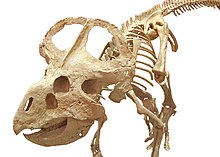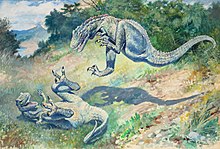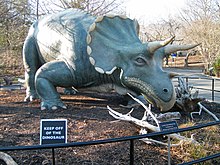Cultural depictions of dinosaurs

Cultural depictions of dinosaurs have been numerous since the word dinosaur was coined in 1842. The non-avian dinosaurs featured in books, films, television programs, artwork, and other media have been used for both education and entertainment. The depictions range from the realistic, as in the television documentaries from the 1990s into the first decades of the 21st century, to the fantastic, as in the monster movies of the 1950s and 1960s.
The growth in interest in dinosaurs since the
Cultural depictions have also created or reinforced misconceptions about dinosaurs and other prehistoric animals, such as inaccurately and anachronistically portraying a sort of "prehistoric world" where many kinds of extinct animals (from the Permian animal Dimetrodon to mammoths and cavemen) lived together, and dinosaurs lived lives of constant combat. Other misconceptions reinforced by cultural depictions came from a scientific consensus that has now been overturned, such as dinosaurs being slow and unintelligent, or the use of dinosaur to describe something that is maladapted or obsolete.
Depictions are necessarily conjectural, because
History of depictions
Early human history to 1900: Early depictions

The classical folklorist Adrienne Mayor has proposed that the profusion of literary descriptions and imagery of the griffin in Greek and Roman literature and art beginning in the 7th century BC to the 3rd century AD were influenced by observations and travelers' accounts of fossilized beaked dinosaur skeletons found in the Turpan and Junggar basins and Gobi Desert. She noted that according to Aristeas, Sophocles, Herodotus, and other ancient writers, griffins were said to inhabit and lay eggs in nests on the ground in the lands beyond the Issedonian territory of the Altai region. Tales of these griffins traveled from east to west along the silk routes. Mayor draws connections to Protoceratops, a frilled dinosaur and Psittacosaur fossils and dinosaur nests with eggs conspicuous in the Gobi,[1] sharing features associated with griffins: sharp beaks, four legs, claws, similar size, large eyes (or eye sockets in the case of the fossils), and the neck frill of Protoceratops, with large open holes, argued as inspiring descriptions of the griffin's large ears or wings.[2] The palaeontologist Mark Witton notes in his blog that Mayor's suggestion ignores pre-Mycenaean accounts, and has not found favour with archaeologists including N. Wyatt and T.F. Tartaron.[3][4][5] Many Near Eastern and Minoan artworks feature imaginary composite creatures, including quadrupeds with birds' heads but these were not called "griffins" and no writings link them to strange beasts of Central Asia. There are no pre-Mycenaean or Minoan texts to relate bird-headed quadrupeds with classical griffins.
According to Mayor,
The scientific study of dinosaurs began in 1820s England. In 1842, Richard Owen coined the term dinosaur, which in his vision were elephantine reptiles. An ambitious promoter of his discoveries and theories, Owen was the driving force for the Crystal Palace dinosaur sculptures, the first large-scale public dinosaur reconstructions (1854). These sculptures, which can still be seen today, immortalized a very early stage in the perception of dinosaurs.[7]

The Crystal Palace sculptures were successful enough that
In the same period, dinosaurs first appeared in popular literature, with a passing mention of an Owen-style Megalosaurus in Charles Dickens's Bleak House (1852–1853).[10] However, depictions of dinosaurs were rare in the 19th century, possibly due to incomplete knowledge. Despite the well-publicized "Bone Wars" of the late 19th century between the American palaeontologists Edward Drinker Cope and Othniel Charles Marsh, dinosaurs were not yet ingrained in culture. Marsh, although a pioneer of skeletal reconstructions, did not support putting mounted skeletons on display, and derided the Crystal Palace sculptures.[11]
1900 to the 1930s: New media

As study caught up to the wealth of new material from western North America, and venues for depictions proliferated, dinosaurs gained in popularity. The paintings of Charles R. Knight were the first influential representations of these finds. Knight worked extensively with the American Museum of Natural History and its director, Henry Fairfield Osborn, who wanted to use dinosaurs and other prehistoric animals to promote his museum[12] and his ideas on evolution.[13]
Knight's work, found in museums around the United States, helped popularize dinosaurs and influenced generations of
Dinosaurs began appearing in films soon after the introduction of cinema, the first being the good-natured animated Gertie the Dinosaur in 1914.[15] However, lovable dinosaurs were quickly replaced as moviemakers recognized the thrill of huge frightening monsters.[16] D. W. Griffith in 1914's Brute Force provided the first example of a threatening cinematic dinosaur, a Ceratosaurus who menaced cavemen. This film enshrined the fiction that dinosaurs and early humans lived together, and set up the cliché that dinosaurs were bloodthirsty and attacked anything that moved.[8]
The now-common
The
The 1930s to the 1970s: Moribund dinosaurs to renaissance

The
Films of the time typically used dinosaurs as monsters, with the added element of atomic fears in the early
In 1956, Oliver Butterworth authored a children's book, The Enormous Egg. The book and a movie adaptation televised in 1968 by the NBC Children's Theatre tell the story of a boy who finds an enormous egg laid by a hen that hatches a baby Triceratops. The dinosaur, named Uncle Beazley, becomes too big, so the boy brings him to the Smithsonian Institution in Washington, D.C. Beazley is first kept at the National Museum of Natural History, but is eventually transferred to the National Zoo's Elephant House because there is a law against stabling large animals in the District of Columbia.[24] In the later part of the book, Uncle Beazley must be saved from a narrow-minded Senator who wants it destroyed. (Senator Joseph McCarthy was at the peak of his career at the time of writing.)
Dinosaurs gained a home in
In the 1960s, paleontologist
Soon thereafter came new evidence on dinosaur social behavior, with nests of Maiasaura suggesting parental care.[30] These findings were reflected in the work of a new generation of paleoartists. One milestone was Sarah Landry's feathered dinosaur in Bakker's 1975 Scientific American article, Dinosaur Renaissance.[18]
Louis Paul Jonas created the first full sized dinosaur sculptures for the 1964 New York World's Fair in the "Dinoland" area, which was sponsored by the Sinclair Oil Corporation, whose logo featured a dinosaur. Jonas consulted with paleontologists Barnum Brown, Edwin H. Colbert and John Ostrom in order to create nine sculptures that were as accurate as possible. After the Fair closed, the dinosaur models toured the country on flatbed trailers as part of a company advertising campaign. Most of the statues are now on display at various museums and parks.[31][32]

In 1967, the Sinclair Oil Corporation gave one of its dinosaurs, a fiberglass model of a Triceratops, to the Smithsonian Institution. The model, which appeared in The Enormous Egg television movie in 1968 as Uncle Beazley, is now on display at the National Zoo in Washington, D.C. From the 1970s to 1994, the statue was located on the National Mall in front of the National Museum of Natural History[34] (some sources state that the Kentucky Science Center in Louisville (formerly named the "Louisville Museum of Natural History and Science" and the "Louisville Science Center") now owns the Triceratops model).[31][32]
The 1980s to the present: Dinosaurs reconsidered


The reevaluation of dinosaurs spurred public interest, with the new generation of paleoartists quick to respond. Artists such as Mark Hallett, Doug Henderson, John Gurche, Gregory S. Paul, William Stout, and Bob Walters illustrated the new findings in response to the demand.[18]
By the latter half of the 1980s and into the 1990s, other media were showing the influence of the increased popularity, with diverse depictions aimed at a variety of ages and interests.
In 1990, the Smithsonian Institution's National Museum of Natural History in Washington, D.C., featured an exhibition of dinosaur sculpture by
For preschoolers, there was the educational television show
Public perception of dinosaurs
The popular ideals of dinosaurs have many
Reports in the news media of dinosaur finds and dinosaur science are often inaccurate and sensationalistic, and popular dinosaur books usually lag scientific understanding.
The pejorative use of "dinosaur" as something behind the times has been applied to people, styles, and ideas that are perceived to be out of date and on the wane.[41] For example, members of the punk movement derided the "progressive" bands that preceded them as "dinosaur bands".[42]
However, some popular depictors have striven for accuracy and presented up-to-date information; Michael Crichton[38] and Bill Watterson (of Calvin and Hobbes)[43] are two recent examples. Paleoartists and illustrators in particular have kept up with research. Popular conceptions of dinosaurs have also been important in stimulating the interest and imagination of young people, and have been responsible for introducing many who would later become paleontologists to the field. In addition, popular depictions have the freedom to be more imaginative and speculative than technical works.[15]
Usage
The typical use of dinosaurs in popular culture has been as vicious monsters.[8] There are several distinct genres of dinosaur depictions commonly used: "lost worlds" on modern Earth; time travel stories; educational works for children;[15] prehistoric world stories (often with cavemen);[38] and dinosaurs running amok in the modern world.[17]
Appeal
The appeal of dinosaurs, as suggested by author, researcher, and dinosaur enthusiast Donald F. Glut, has multiple factors. Dinosaurs were "monsters," yet are safely extinct, allowing for vicarious thrills. They appeal to the imagination, and there are many ways to approach them intellectually. Finally, they appeal to adults nostalgic for what they enjoyed as children. Children have been particularly drawn to dinosaurs over the years.[8]
Impact of the dinosaur on society
The scientific discoveries of dinosaurs sometimes led to creation of local museums with positive impact on the local society and economy. Some of the best examples are the dinosaurs from Lourinhã Formation that changed the town of Lourinhã, in Portugal, famous for the dinosaur eggs. Found in the Upper Jurassic outcrops of Lourinhã, Portugal, and first published in 1997, the Paimogo dinosaur egg clutch is one of Portugal's most remarkable fossils, with over one hundred eggs preserved in association with embryonic bones, of the allosauroid theropod Lourinhanosaurus. However, many questions about it have remained unanswered, even until the present day. After its discovery, this extraordinary fossil became the keystone of a small local museum, greatly kick-starting regional tourism, while also holding the fossils in trust for future generations to study. More than 20 years later, continually sustained paleontological interest from the public has even given rise to both a highly successful dinosaur theme park in the region and an aspiring UNESCO Geopark.[44]
In texting and computer technology
In April 2016, a proposal was submitted to the
See also
- Cultural depictions of penguins
- Cultural depictions of ravens
- Dinosaur renaissance
- Golden eagles in human culture
- List of fictional birds
- List of fictional dinosaurs
- List of films featuring dinosaurs
- List of U.S. state birds
- List of U.S. state dinosaurs
- Paleoart
- Prehistory Park
- Reptiles in culture
- Stegosaurus in popular culture
- Tyrannosaurus in popular culture
- Velociraptor in popular culture
References
- ISBN 978-0-691-05863-4.
- ISBN 978-0-691-05900-6.
- ^ Witton, Mark. "Why Protoceratops Almost Certainly Wasn't The Inspiration For Griffin Legend". Retrieved 2 July 2016.
- ^ Tartaron, T. F. (2014). Cross-Cultural Interaction in the Greek World: Culture Contact Issues and Theories. In Encyclopedia of Global Archaeology (pp. 1804–1821). Springer New York.
- ^ Wyatt, N. (2009). Grasping the Griffin: Identifying and Characterizing the Griffin in Egyptian and West Semitic Tradition. Journal of Ancient Egyptian Interconnections, 1(1), 29–39.
- JSTOR j.ctt4cgcs9.10.
- ^ Torrens, Hugh. "Politics and Paleontology". The Complete Dinosaur, 175–190.
- ^ ISBN 978-0-253-33349-0.
- .
- ^ "London. Michaelmas term lately over, and the Lord Chancellor sitting in Lincoln's Inn Hall. Implacable November weather. As much mud in the streets, as if the waters had but newly retired from the face of the earth, and it would not be wonderful to meet a Megalosaurus, forty feet long or so, waddling like an elephantine lizard up Holborne Hill." From page 1 of Dickens, Charles J.H. (1852). Bleak House, Chapter I: In Chancery. London: Bradbury & Evans.
- ^ Dodson, Peter. The Horned Dinosaurs, 74–75.
- ^ ISBN 978-0-312-26226-6.
- S2CID 86048630.
- ISBN 978-0-14-010055-6.
- ^ ISBN 978-0-253-33907-2.
- ISBN 978-0-8109-0922-9.
- ^ ISBN 978-0-380-75896-8.
- ^ ISBN 978-0-312-26226-6.
- ISBN 978-0-89464-985-1.
- ^ Bakker, Robert T. The Dinosaur Heresies, 447–449.
- ^ Bakker, Robert T. The Dinosaur Heresies, 15–16.
- ^ "Definition of dinosaur" Merriam-Webster's Online Dictionary. Accessed 26 May 2007.
- ^ Snider, Mike (2006-08-29). "Godzilla arouses atomic terror". USA Today. Gannett Corporation. Retrieved 2007-02-21.
- OCLC 299175. Retrieved July 4, 2016. (2) "About this book". The Enormous Egg by Oliver Butterworth, illustrated by Louis Darling. Scholastic Inc. 2016. Archived from the original on August 31, 2012. Retrieved July 3, 2016.
At first Nate doesn't see what all the fuss is all about. All he wants is to keep his new pet. But Uncle Beazley, the dinosaur himself, just keeps getting bigger and bigger ...
(3) "NBC Children's Theatre (1963–1973): The Enormous Egg: Episode aired April 18, 1968". IMDb.com, Inc. 2008. Archived from the original on March 9, 2008. Retrieved July 3, 2016. (4) MacIntyre, F Gwynplaine (May 28, 2003). "User Comment". NBC Children's Theatre (1963–1973): The Enormous Egg: Episode aired April 18, 1968. IMDb.com, Inc. Archived from the original on March 9, 2008. Retrieved July 3, 2016. - OCLC 679420.
- ^ The term has entered into common usage after an article of the same name by paleontologist Robert T. Bakker in Scientific American, in April 1975. Examples can be found here Archived 2007-09-27 at the Wayback Machine and here Archived 2006-01-10 at the Wayback Machine.
- S2CID 85396846.
- ^ Bakker, Robert T. (1968). "The superiority of dinosaurs". Discovery. 3 (2): 11–22.
- S2CID 4220935.
- S2CID 4370793.
- ^ a b "Sinclair at the New York World's Fair". 1960s. Sinclair Oil Corporation. Archived from the original on May 5, 2016. Retrieved July 4, 2016.
- ^ a b "Sinclair Dinoland: New York World's Fair 1964–65". Science Leads the Way. Frank J. Leskovitz. 2016. Archived from the original on March 5, 2016. Retrieved July 2, 2016.
- ^ (1) "Sinclair's New York World's Fair (1964–65) "Dinoland" Pavilion". Sinclair History. Sinclair Oil Corporation. 2013. Archived from the original on May 9, 2015. Retrieved July 11, 2016. (2) "Dinosaur Fever – Sinclair's Icon". Petroleum History Almanac. Washington, D.C.: American Oil & Gas Historical Society. 2016. Archived from the original on April 10, 2016. Retrieved July 2, 2016. (3) "Sinclair Dinoland: New York World's Fair 1964–65". Science Leads the Way. Frank J. Leskovitz. 2016. Archived from the original on March 5, 2016. Retrieved July 2, 2016. (4) "Ankylosaurus at HMNS: 40 Year Mystery Solved". Houston Museum of Natural Science. Retrieved August 4, 2014.
- OCLC 2610663. Retrieved 2016-07-04.
Title: Uncle Beazley...This 25-foot long replica of a Triceratops...as placed on the Mall in 1967...
The full-size Triceratops replica and eight other types of dinosaurs were designed by two prominent paleontologists, Dr. Barnum Brown of the American Museum of Natural History, in New York City, and Dr. John Ostrom of the Peabody Museum, in Peabody, Massachusetts. The sculptor, Louis Paul Jonas, executed these prehistoric animals in fiberglass, after the designs of Barnum and Ostrom, for the Sinclair Refining Company's Pavilion at the New York World's Fair of 1964. After the Fair closed, the nine dinosaurs, which weighed between 2 and 4 tons each, were placed on trucks and taken on a tour of the eastern United States. The Sinclair Refining Company promoted the tour for public relations and advertising purposes, since their trademark was the dinosaur. In 1967, the nine dinosaurs were given to various American museums. This particular replica was used for the filming of The Enormous Egg, a movie made by theNational Broadcasting Companyfor television, based on a children's book of the same name by Oliver Buttersworth. The movie features an enormous egg, out of which hatches a baby Tricerotops; the boy consults with the Smithsonian Institution which accepts Uncle Beazley for the National Zoo. (2) "A Dinosaur at the Zoo". Art at the National Zoo. Washington, D.C.: Smithsonian National Zoological Park. Archived from the original on June 12, 2007. Retrieved July 1, 2016. (3) "Uncle Beazley". Histories of the National Mall. Fairfax, Virginia: Roy Rosenzweig Center for History and New Media, George Mason University. Archived from the original on April 16, 2016. Retrieved July 1, 2016.For a slow-moving dinosaur, Uncle Beazley is widely traveled. Before coming to the Mall in the 1970s, his home was the Smithsonian's Anacostia Neighborhood Museum. In 1994, Uncle Beazley moved from the Mall to his current residence, the National Zoo.
- ^ Roth, Andrew (2006-02-14). "Jim Gary". The Guardian. Retrieved 2008-08-06.
- ^ Celeskey, Matt (2006-01-17). "Sculptor Jim Gary dies". Hairy Museum of Natural History. Archived from the original on 2008-07-05. Retrieved 2008-08-06.
- National Geographic World, September 1978, cover and pages 4-7
- ^ ISBN 978-0-07-303642-7.
- S2CID 129654916. Archived from the originalon May 25, 2013.
- S2CID 2659741.
- ^ "dinosaur". Dictionary.com. Lexico Publishing Group, LLC. Retrieved 2008-08-06.
- ISBN 978-0-946719-70-9.
- ^ Farlow, James O. and Brett-Surman, Michael K. The Complete Dinosaur, Plate 22.
- S2CID 235749967.
- ^ Milan, Courtney (April 2, 2016). "Jurassic Emoji Proposal" (PDF). Document L2/16-072. Unicode Technical Committee. Retrieved April 13, 2016.
- ^ "T-Rex Emoji".
- ^ "Sauropod Emoji".
Further reading
- Allen A. Debus, Diane E. Debus, "Paleoimagery: The Evolution of Dinosaurs in Art", 2002
- Allen A. Debus, "Dinosaurs in Fantastic Fiction: A Thematic Survey", ISBN 0-7864-2672-1, 2006
- Zoë Lescaze (Editor), "Paläo-Art", Taschen, ISBN 978-3836565844, 2017
- Alexis Dworsky "Dionsaurier! Die Kulturgeschichte", ISBN 978-3770552221, 2011 (German, English summary)
External links
 Media related to Dinosaurs in fiction at Wikimedia Commons
Media related to Dinosaurs in fiction at Wikimedia Commons- Dinosaur Tracking: Where Paleontology Meets Pop Culture, at Smithsonian.com

